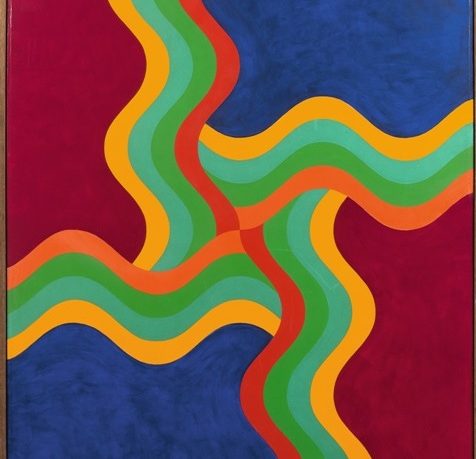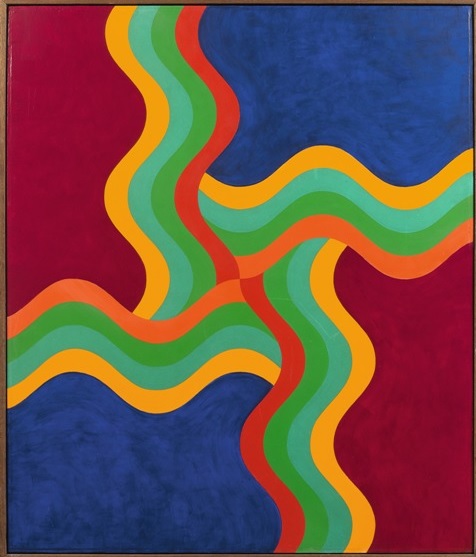BLOUIN ARTINFO
BY DEVORAH LAUTER
A few years after Morocco’s independence, the Casablanca Art School began introducing radical modern art practice and theory into its curriculum, spurring its own movement that drew inspiration from Moroccan artistic heritage, international art and a grassroots approach that opposed the colonial establishment.
The school’s efforts helped build an important cross roads for artists and thinkers of the region.
Leading the way was a hard-edged Moroccan artist and teacher at the school, Mohamed Melehi (born 1936), whose work is currently on display, along with never-before-exhibited documentation illustrating the scope and vision of the Casablanca movement he helped lead between 1962 and 1974. The exhibition is on view at the Mosaic Rooms in London until June 22, 2019.
“The Casablanca Art School made this great rupture from the colonial mindset—which undermined Moroccan artists at the time—by exhibiting their paintings in the street, in a very popular square [the Jemaa el-Fnaa square, Marrakesh in 1969], where the outdoor presence and display of the paintings reconnected the issues of Moroccan avant-garde with the everyday, with the street,” said the curator,Morad Montazami. The now legendary street exhibit, “Presence Plastique,”was a natural alternative to a museum for Melehi and fellow teachers at the Casablanca Art School, who wanted to thwart colonial dogma. Melehi’s cohort included theartists Farid Belkhahia, Mohamed Chabaa, as well as the theoreticians, Toni Maraini and Bert Flint.
The Mosaic Rooms show is the last in a series of exhibitions on modern artists from Egypt, Iran and Morocco underscoring how, “art history should explore new links between different, more peripheral places of modernity, that I try to relocate as central hubs,” said Montazami, who curated the series.With Morocco as, “one of the first places for independent art spaces in the Global South,” the Casablanca Art School was critical, but “remained very much undocumented and unseen from a museum point of view, until now,” he added.
Though independence was won in 1956, colonial-established salons still dismissed Moroccan creators as naive folk artists. In response, Melehi and his collaborators at the Casablanca Art School looked for inspiration in the region’s cultural past. They led their students on research expeditions to rural villages where they discovered the geometric patterns and artwork of Berber tribes people on traditional rugs, jewelry, tattoos, pre-Islamic mosques and other architecture. Other important influences on the movement included international artistic impulses, such as Bauhaus abstract geometrization, or hard-edge paintings from America.
This particular decade at the Casablanca school “encapsulated a lot of experimental issues that Middle Eastern and North African artists are still debating,” said Montazami. “Be it the issue of neo-calligraphic experiment, plastic experiment over calligraphy, or the combination of performative, site-specific works with abstract experimentation, and so many practices that today take a new, relevant signification.”
Nevertheless, none of the students during this unusual period reached the kind of international recognition that the movement’s leaders were able to achieve.
Photographs of the school’s exhibits, classes, expeditions, sketches and samples of exceptional Berber creations are included in the show. Their connection is thus made particularly tangible to the exhibit’s central figure: Melehi and his warm, colorful wave motifs and crisp, geometric pattern paintings, some of which shift into their own, psychedelic realm, lighting up the room.
Rarely seen Melehi works were loaned by the artist and private collections, while work from his prolific career as a graphic designer, muralist, sculptor, painter are also on display. In addition, the exhibit explores his role as a leftist political activist who shaped art networks in the Maghreb and Pan-Arab world. Due to the absence of institutional archives, historic documentation about the movement was gathered from witnesses and individuals involved, in what the curator described as an endless research process.
It is no accident if the show portrays a sense of being overwhelmed. “It’s too excessive for a museum display, too unorthodox,”and was designed purposefully as “a reminder of the hectic and infinite research behind it,” said Montazami. “I want [the exhibit] to be basically like fireworks. I want it to explode on the wall.”
After building his career within the post-war art scenes of Rome and New York(including participation in the 1963 exhibit“Formalists” at the Washington Gallery of Modern Art with artists Josef Albers and Frank Stella), Melehi returned to Morocco in 1964, where he joined the teaching staff at the Casablanca Art School. Today Melehi lives and works between Marrakech and Tangier.
“New Waves: Mohamed Melehi and the Casablanca Art School,” is on view until June 22, 2019 at The Mosaic Rooms in London.
More information: www.mosaicrooms.org








